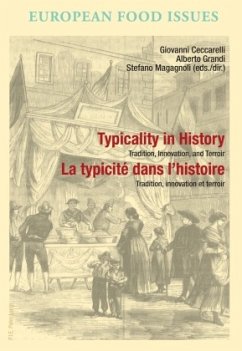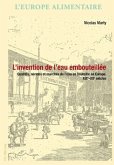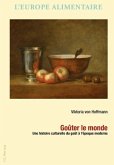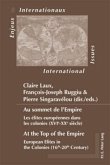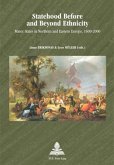Typicality in History / La typicité dans l'histoire
Tradition, Innovation, and Terroir / Tradition, innovation et terroir
Herausgegeben:Ceccarelli, Giovanni; Grandi, Alberto; Magagnoli, Stefano
Typicality in History / La typicité dans l'histoire
Tradition, Innovation, and Terroir / Tradition, innovation et terroir
Herausgegeben:Ceccarelli, Giovanni; Grandi, Alberto; Magagnoli, Stefano
- Broschiertes Buch
- Merkliste
- Auf die Merkliste
- Bewerten Bewerten
- Teilen
- Produkt teilen
- Produkterinnerung
- Produkterinnerung
Typical food is an in-vogue topic, embodying issues such as current trends in food globalization and European Union policies on agriculture and trade. It is, however, striking how little is known about its history. This book, inspired by the conference La tipicità nella storia: tradizione, innovazione, territorio , held in Parma and Langhirano in 2010, is an attempt to fill this gap. It includes essays by historians, sociologists, economists and experts in the food industry, who cover a wide range of products (wine, cheese, chocolate, cider), across a broad geographic scope (from France to…mehr
Andere Kunden interessierten sich auch für
![L'invention de l'eau embouteillée L'invention de l'eau embouteillée]() Nicolas MartyL'invention de l'eau embouteillée61,60 €
Nicolas MartyL'invention de l'eau embouteillée61,60 €![Goûter le monde Goûter le monde]() Viktoria von HoffmannGoûter le monde52,80 €
Viktoria von HoffmannGoûter le monde52,80 €![Au sommet de l'Empire / At the Top of the Empire Au sommet de l'Empire / At the Top of the Empire]() Au sommet de l'Empire / At the Top of the Empire69,15 €
Au sommet de l'Empire / At the Top of the Empire69,15 €![Statehood Before and Beyond Ethnicity Statehood Before and Beyond Ethnicity]() Statehood Before and Beyond Ethnicity95,75 €
Statehood Before and Beyond Ethnicity95,75 €![Radical Unions in Europe and the Future of Collective Interest Representation Radical Unions in Europe and the Future of Collective Interest Representation]() Radical Unions in Europe and the Future of Collective Interest Representation80,20 €
Radical Unions in Europe and the Future of Collective Interest Representation80,20 €![Integration - Legitimation - Korruption- Integration - Legitimation - Corruption Integration - Legitimation - Korruption- Integration - Legitimation - Corruption]() Integration - Legitimation - Korruption- Integration - Legitimation - Corruption80,30 €
Integration - Legitimation - Korruption- Integration - Legitimation - Corruption80,30 €![Army of the Sky Army of the Sky]() Gregory VitarboArmy of the Sky92,95 €
Gregory VitarboArmy of the Sky92,95 €-
-
-
Typical food is an in-vogue topic, embodying issues such as current trends in food globalization and European Union policies on agriculture and trade. It is, however, striking how little is known about its history. This book, inspired by the conference La tipicità nella storia: tradizione, innovazione, territorio , held in Parma and Langhirano in 2010, is an attempt to fill this gap. It includes essays by historians, sociologists, economists and experts in the food industry, who cover a wide range of products (wine, cheese, chocolate, cider), across a broad geographic scope (from France to Costa Rica and Norway) and time frame (from the Middle Ages to the present day). Besides the crucial issue of when and why the link between food and place of origin emerged, the contributors look at interactions between physical terroir and human savoir - faire and also between industrial innovation and traditional skills. Typicality is usually considered as a bottom-up process but the role of institutional protection is also examined. Designation of origin can be seen as a qualitative safeguard for food production, yet its influence on consumers' choices is emphasized as well. In its approach, this multi-faceted book questions the oversimplified idea of typicality arising from a vaguely defined traditional food heritage. In 2010, the editors of this book founded the Food Lab, a research laboratory on food history based in the Department of Economics at the University of Parma.
This book contains articles in English and French.
This book contains articles in English and French.
Produktdetails
- Produktdetails
- L'Europe alimentaire / European Food Issues / Europa alimentaria / L'Europa alimentare 4
- Verlag: Peter Lang
- Artikelnr. des Verlages: 574007
- 1. Auflage
- Seitenzahl: 480
- Erscheinungstermin: 19. Juni 2013
- Englisch, Französisch
- Abmessung: 220mm x 150mm x 26mm
- Gewicht: 650g
- ISBN-13: 9782875740076
- ISBN-10: 2875740075
- Artikelnr.: 38512971
- Herstellerkennzeichnung
- Lang, Peter GmbH
- Gontardstraße 11
- 10178 Berlin
- r.boehm-korff@peterlang.com
- L'Europe alimentaire / European Food Issues / Europa alimentaria / L'Europa alimentare 4
- Verlag: Peter Lang
- Artikelnr. des Verlages: 574007
- 1. Auflage
- Seitenzahl: 480
- Erscheinungstermin: 19. Juni 2013
- Englisch, Französisch
- Abmessung: 220mm x 150mm x 26mm
- Gewicht: 650g
- ISBN-13: 9782875740076
- ISBN-10: 2875740075
- Artikelnr.: 38512971
- Herstellerkennzeichnung
- Lang, Peter GmbH
- Gontardstraße 11
- 10178 Berlin
- r.boehm-korff@peterlang.com
Giovanni Ceccarelli teaches the history of globalization at the University of Parma. He has combined his research interests in late medieval trade and food history, and focuses in particular on the use of a product¿s origins as a marketing technique in early modern Europe. Alberto Grandi is Associate Professor of Economic History at the University of Parma. He has previously worked on guilds in early modern Europe and regional development in twentieth-century Italy. These two lines of research have found a synthesis in food history, with specific reference to the emergence of typical products and designations of origin. Stefano Magagnoli teaches the history of European integration at the University of Parma. His research concerns the interaction between institutions and economic growth during the twentieth century. In particular, he is interested in how food traditions have been reinvented and used to support local development.
Contents: Giovanni Ceccarelli/Alberto Grandi/Stefano Magagnoli: Typicality in History. Tracing a Basic Definition - Madeleine Ferrières : Terroir : jalons pour l'histoire d'un mot - Maura Franchi: The Contents of Typical Food Products: Tradition, Myth, Memory. Some Notes on Nostalgia Marketing - Giovanni Ceccarelli/Alberto Grandi/Stefano Magagnoli: The Avatar: An Economic History Paradigm for Typical Products - Laura Prosperi: The Building of Typicality as Food Pattern (Italy, XIVth-XVIth Centuries) - Philippe Meyzie : La construction des «spécialités» culinaires du Sud-Ouest de la France (XVIIIe-XIXe siècles) - Anneke Geyzen: Imagining Identities. Women's Magazines and the Invention of Culinary Traditions in Flanders (1945-1970) - Virginie Amilien: Typical Food in Norway. A Developer of History and Tradition - Régis Huguenin: The Swiss Milk Chocolate. A Typical Image for an Atypical Product - Fabio Parasecoli: Costa Rica Between Trademarks and Geographical Indications. A Case Study in the Development of Typicality - Stefan Kah/Norbert Weixlbaumer: «Walser's pride»: A Mountain Cheese as Part of Regional Identity and Regional Development Strategies in the Biosphere Reserve Großes Walsertal - Austria - Cristina Grasseni : Produits typiques alpins, écomusées et marketing territorial comme stratégies de distinction et de survie - Sylvain Brunier/Hakim Bourfouka : Appellations d'origine conseillées. Histoire des conseillers agricoles et des produits typiquement savoyards (1950-1985) - David Burigana : L'Italie, la France et les fromages «typiques» (1950-2009). Aux origines d'une politique étrangère européenne? - Gloria Sanz Lafuente: Defining Good and Bad Products. The Building of Scientific Consensus on the Purity of Cider in Spain from the End of the XIXth Century to the First Decade of the XXth Century - Christian Barrère: The Strategic Building of Typicality. Learning from the Comparative History of Three French Sparkling Vineyards - Simone Kovatz: The Geography of Quality Wine in United Italy. Areas and Producers - Luca Mocarelli: The Long Struggle for the Chianti Denomination. Quality versus Quantity - Ezio Ritrovato : Des vins de coupage aux étiquettes à succès. Typicité et culture oenologique dans le développement territorial des Pouilles (Puglie) - Annunziata Berrino: Tourism and Typicality in Italy, 1980-2010 - Marie-Lucie Rossi : Produits régionaux et développement territorial. Reggio Emilia au XIXe siècle - Mario Zannoni: Factors Influencing the Sensory Features of Parmigiano-Reggiano from the Renaissance to the Present Day - Giancarlo Gonizzi/Gianluigi Zenti: Beyond Business: «Academia Barilla» and the Defense of the Italian Way of Eating - Jean-Pierre Williot: Perspectives.Contents: Giovanni Ceccarelli/Alberto Grandi/Stefano Magagnoli: Typicality in History. Tracing a Basic Definition - Madeleine Ferrières : Terroir : jalons pour l'histoire d'un mot - Maura Franchi: The Contents of Typical Food Products: Tradition, Myth, Memory. Some Notes on Nostalgia Marketing - Giovanni Ceccarelli/Alberto Grandi/Stefano Magagnoli: The Avatar: An Economic History Paradigm for Typical Products - Laura Prosperi: The Building of Typicality as Food Pattern (Italy, XIV th -XVI th Centuries) - Philippe Meyzie : La construction des "spécialités" culinaires du Sud-Ouest de la France (XVIII e -XIX e siècles) - Anneke Geyzen: Imagining Identities. Women's Magazines and the Invention of Culinary Traditions in Flanders (1945-1970) - Virginie Amilien: Typical Food in Norway. A Developer of History and Tradition - Régis Huguenin: The Swiss Milk Chocolate. A Typical Image for an Atypical Product - Fabio Parasecoli: Costa Rica Between Trademarks and Geographical Indications. A Case Study in the Development of Typicality - Stefan Kah/Norbert Weixlbaumer: "Walser's pride": A Mountain Cheese as Part of Regional Identity and Regional Development Strategies in the Biosphere Reserve Großes Walsertal - Austria - Cristina Grasseni : Produits typiques alpins, écomusées et marketing territorial comme stratégies de distinction et de survie - Sylvain Brunier/Hakim Bourfouka : Appellations d'origine conseillées. Histoire des conseillers agricoles et des produits typiquement savoyards (1950-1985) - David Burigana : L'Italie, la France et les fromages "typiques" (1950-2009). Aux origines d'une politique étrangère européenne? - Gloria Sanz Lafuente: Defining Good and Bad Products. The Building of Scientific Consensus on the Purity of Cider in Spain from the End of the XIX th Century to the First Decade of the XX th Century - Christian Barrère: The Strategic Building of Typicality. Learning from the Comparative History of Three French Sparkling Vineyards - Simone Kovatz: The Geography of Quality Wine in United Italy. Areas and Producers - Luca Mocarelli: The Long Struggle for the Chianti Denomination. Quality versus Quantity - Ezio Ritrovato : Des vins de coupage aux étiquettes à succès. Typicité et culture oenologique dans le développement territorial des Pouilles (Puglie) - Annunziata Berrino: Tourism and Typicality in Italy, 1980-2010 - Marie-Lucie Rossi : Produits régionaux et développement territorial. Reggio Emilia au XIX e siècle - Mario Zannoni: Factors Influencing the Sensory Features of Parmigiano-Reggiano from the Renaissance to the Present Day - Giancarlo Gonizzi/Gianluigi Zenti: Beyond Business: "Academia Barilla" and the Defense of the Italian Way of Eating - Jean-Pierre Williot: Perspectives.
Contents: Giovanni Ceccarelli/Alberto Grandi/Stefano Magagnoli: Typicality in History. Tracing a Basic Definition - Madeleine Ferrières : Terroir : jalons pour l'histoire d'un mot - Maura Franchi: The Contents of Typical Food Products: Tradition, Myth, Memory. Some Notes on Nostalgia Marketing - Giovanni Ceccarelli/Alberto Grandi/Stefano Magagnoli: The Avatar: An Economic History Paradigm for Typical Products - Laura Prosperi: The Building of Typicality as Food Pattern (Italy, XIVth-XVIth Centuries) - Philippe Meyzie : La construction des «spécialités» culinaires du Sud-Ouest de la France (XVIIIe-XIXe siècles) - Anneke Geyzen: Imagining Identities. Women's Magazines and the Invention of Culinary Traditions in Flanders (1945-1970) - Virginie Amilien: Typical Food in Norway. A Developer of History and Tradition - Régis Huguenin: The Swiss Milk Chocolate. A Typical Image for an Atypical Product - Fabio Parasecoli: Costa Rica Between Trademarks and Geographical Indications. A Case Study in the Development of Typicality - Stefan Kah/Norbert Weixlbaumer: «Walser's pride»: A Mountain Cheese as Part of Regional Identity and Regional Development Strategies in the Biosphere Reserve Großes Walsertal - Austria - Cristina Grasseni : Produits typiques alpins, écomusées et marketing territorial comme stratégies de distinction et de survie - Sylvain Brunier/Hakim Bourfouka : Appellations d'origine conseillées. Histoire des conseillers agricoles et des produits typiquement savoyards (1950-1985) - David Burigana : L'Italie, la France et les fromages «typiques» (1950-2009). Aux origines d'une politique étrangère européenne? - Gloria Sanz Lafuente: Defining Good and Bad Products. The Building of Scientific Consensus on the Purity of Cider in Spain from the End of the XIXth Century to the First Decade of the XXth Century - Christian Barrère: The Strategic Building of Typicality. Learning from the Comparative History of Three French Sparkling Vineyards - Simone Kovatz: The Geography of Quality Wine in United Italy. Areas and Producers - Luca Mocarelli: The Long Struggle for the Chianti Denomination. Quality versus Quantity - Ezio Ritrovato : Des vins de coupage aux étiquettes à succès. Typicité et culture oenologique dans le développement territorial des Pouilles (Puglie) - Annunziata Berrino: Tourism and Typicality in Italy, 1980-2010 - Marie-Lucie Rossi : Produits régionaux et développement territorial. Reggio Emilia au XIXe siècle - Mario Zannoni: Factors Influencing the Sensory Features of Parmigiano-Reggiano from the Renaissance to the Present Day - Giancarlo Gonizzi/Gianluigi Zenti: Beyond Business: «Academia Barilla» and the Defense of the Italian Way of Eating - Jean-Pierre Williot: Perspectives.Contents: Giovanni Ceccarelli/Alberto Grandi/Stefano Magagnoli: Typicality in History. Tracing a Basic Definition - Madeleine Ferrières : Terroir : jalons pour l'histoire d'un mot - Maura Franchi: The Contents of Typical Food Products: Tradition, Myth, Memory. Some Notes on Nostalgia Marketing - Giovanni Ceccarelli/Alberto Grandi/Stefano Magagnoli: The Avatar: An Economic History Paradigm for Typical Products - Laura Prosperi: The Building of Typicality as Food Pattern (Italy, XIV th -XVI th Centuries) - Philippe Meyzie : La construction des "spécialités" culinaires du Sud-Ouest de la France (XVIII e -XIX e siècles) - Anneke Geyzen: Imagining Identities. Women's Magazines and the Invention of Culinary Traditions in Flanders (1945-1970) - Virginie Amilien: Typical Food in Norway. A Developer of History and Tradition - Régis Huguenin: The Swiss Milk Chocolate. A Typical Image for an Atypical Product - Fabio Parasecoli: Costa Rica Between Trademarks and Geographical Indications. A Case Study in the Development of Typicality - Stefan Kah/Norbert Weixlbaumer: "Walser's pride": A Mountain Cheese as Part of Regional Identity and Regional Development Strategies in the Biosphere Reserve Großes Walsertal - Austria - Cristina Grasseni : Produits typiques alpins, écomusées et marketing territorial comme stratégies de distinction et de survie - Sylvain Brunier/Hakim Bourfouka : Appellations d'origine conseillées. Histoire des conseillers agricoles et des produits typiquement savoyards (1950-1985) - David Burigana : L'Italie, la France et les fromages "typiques" (1950-2009). Aux origines d'une politique étrangère européenne? - Gloria Sanz Lafuente: Defining Good and Bad Products. The Building of Scientific Consensus on the Purity of Cider in Spain from the End of the XIX th Century to the First Decade of the XX th Century - Christian Barrère: The Strategic Building of Typicality. Learning from the Comparative History of Three French Sparkling Vineyards - Simone Kovatz: The Geography of Quality Wine in United Italy. Areas and Producers - Luca Mocarelli: The Long Struggle for the Chianti Denomination. Quality versus Quantity - Ezio Ritrovato : Des vins de coupage aux étiquettes à succès. Typicité et culture oenologique dans le développement territorial des Pouilles (Puglie) - Annunziata Berrino: Tourism and Typicality in Italy, 1980-2010 - Marie-Lucie Rossi : Produits régionaux et développement territorial. Reggio Emilia au XIX e siècle - Mario Zannoni: Factors Influencing the Sensory Features of Parmigiano-Reggiano from the Renaissance to the Present Day - Giancarlo Gonizzi/Gianluigi Zenti: Beyond Business: "Academia Barilla" and the Defense of the Italian Way of Eating - Jean-Pierre Williot: Perspectives.

